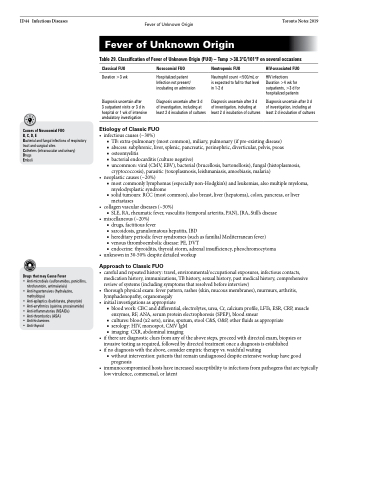Page 644 - TNFlipTest
P. 644
ID44 Infectious Diseases
Fever of Unknown Origin Toronto Notes 2019
Fever of Unknown Origin
Table 29. Classification of Fever of Unknown Origin (FUO) – Temp >38.3°C/101°F on several occasions
Classical FUO
Duration >3 wk
Diagnosis uncertain after
3 outpatient visits or 3 d in hospital or 1 wk of intensive ambulatory investigation
Nosocomial FUO
Hospitalized patient Infection not present/ incubating on admission
Diagnosis uncertain after 3 d of investigation, including at least 2 d incubation of cultures
Neutropenic FUO
Neutrophil count <500/mL or is expected to fall to that level in 1-2 d
Diagnosis uncertain after 3 d of investigation, including at least 2 d incubation of cultures
HIV-associated FUO
HIV infections Duration >4 wk for outpatients, >3 d for hospitalized patients
Diagnosis uncertain after 3 d of investigation, including at least 2 d incubation of cultures
Causes of Nosocomial FUO
B,C,D,E
Bacterial and fungal infections of respiratory tract and surgical sites
Catheters (intravascular and urinary)
Drugs
Emboli
Etiology of Classic FUO
Drugs that may Cause Fever
• Anti-microbials (sulfonamides, penicillins, nitrofurantoin, antimalarials)
• Anti-hypertensives (hydralazine, methyldopa)
• Anti-epileptics (barbiturate, phenytoin)
• Anti-arrythmics (quinine, procainamide)
• Anti-inflammatories (NSAIDs)
• Anti-thrombotics (ASA)
• Anti-histamines
• Anti-thyroid
• infectiouscauses(~30%)
■ TB: extra-pulmonary (most common), miliary, pulmonary (if pre-existing disease)
■ abscess: subphrenic, liver, splenic, pancreatic, perinephric, diverticular, pelvis, psoas
■ osteomyelitis
■ bacterial endocarditis (culture negative)
■ uncommon: viral (CMV, EBV), bacterial (brucellosis, bartonellosis), fungal (histoplasmosis,
cryptococcosis), parasitic (toxoplasmosis, leishmaniasis, amoebiasis, malaria) • neoplasticcauses(~20%)
■ most commonly lymphomas (especially non-Hodgkin’s) and leukemias, also multiple myeloma, myelodysplastic syndrome
■ solid tumours: RCC (most common), also breast, liver (hepatoma), colon, pancreas, or liver metastases
• collagenvasculardiseases(~30%)
■ SLE, RA, rheumatic fever, vasculitis (temporal arteritis, PAN), JRA, Still’s disease
• miscellaneous(~20%)
■ drugs, factitious fever
■ sarcoidosis, granulomatous hepatitis, IBD
■ hereditary periodic fever syndromes (such as familial Mediterranean fever)
■ venous thromboembolic disease: PE, DVT
■ endocrine: thyroiditis, thyroid storm, adrenal insufficiency, pheochromocytoma
• unknownin30-50%despitedetailedworkup
Approach to Classic FUO
• carefulandrepeatedhistory:travel,environmental/occupationalexposures,infectiouscontacts, medication history, immunizations, TB history, sexual history, past medical history, comprehensive review of systems (including symptoms that resolved before interview)
• thorough physical exam: fever pattern, rashes (skin, mucous membranes), murmurs, arthritis, lymphadenopathy, organomegaly
• initialinvestigationsasappropriate
■ blood work: CBC and differential, electrolytes, urea, Cr, calcium profile, LFTs, ESR, CRP, muscle
enzymes, RF, ANA, serum protein electrophoresis (SPEP), blood smear
■ cultures: blood (x2 sets), urine, sputum, stool C&S, O&P, other fluids as appropriate
■ serology: HIV, monospot, CMV IgM ■ imaging: CXR, abdominal imaging
• iftherearediagnosticcluesfromanyoftheabovesteps,proceedwithdirectedexam,biopsiesor invasive testing as required, followed by directed treatment once a diagnosis is established
• ifnodiagnosiswiththeabove,considerempirictherapyvs.watchfulwaiting
■ without intervention: patients that remain undiagnosed despite extensive workup have good
prognosis
• immunocompromisedhostshaveincreasedsusceptibilitytoinfectionsfrompathogensthataretypically
low virulence, commensal, or latent


